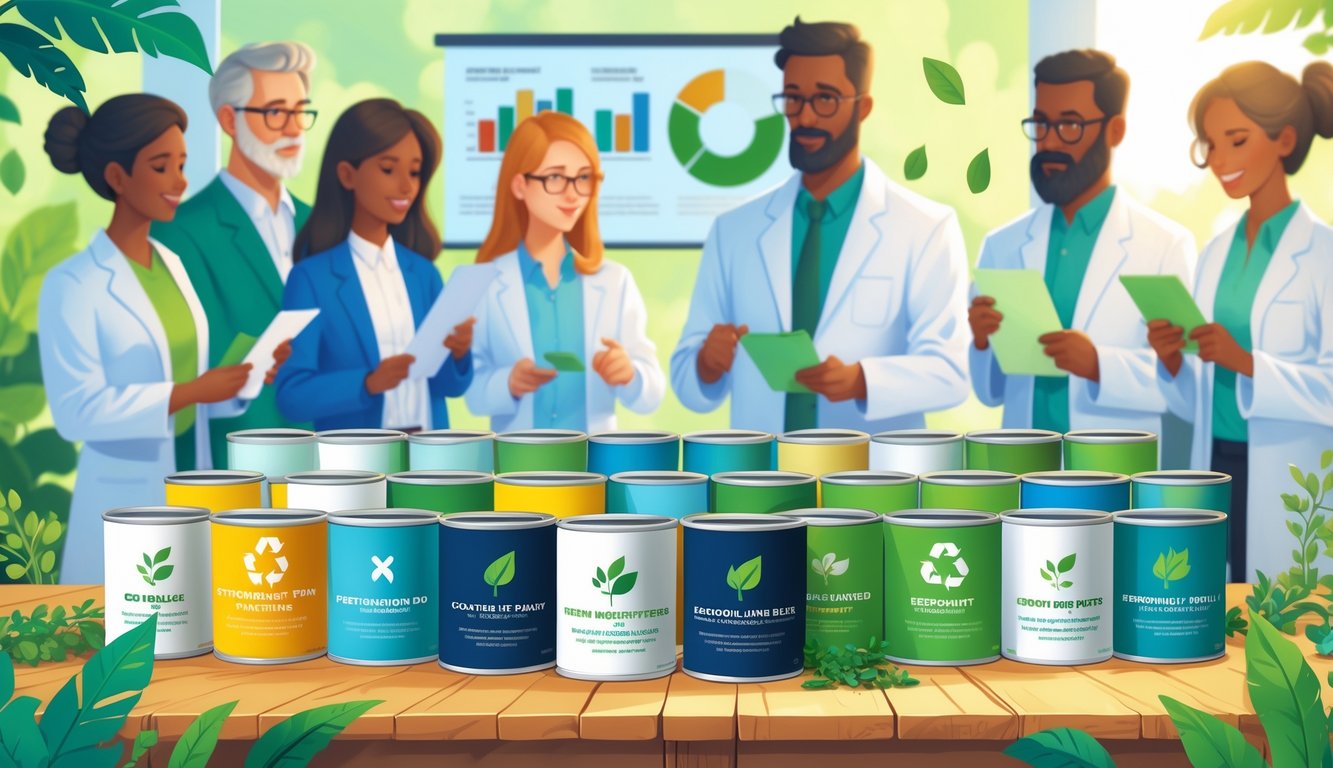
Biodegradable and Sustainable Components
Now the weird part—“biodegradable” on a label doesn’t mean your drop cloth will compost after the job. SISU Painting says most eco paints use renewable fillers like cellulose, chalk, or casein, but almost none break down in a regular landfill. I called a lab in Oregon—apparently, clay-based paints degrade if you compost them hot, but not in a trash bag.
Biodegradability depends on the binders (plant latex, proteins) and whether pigments avoid heavy metals or plastics. One time I bought a “natural” paint online—turns out it had synthetic resin and survived three winters in my shed. So much for breaking down. Water-based paints that meet LEED or Cradle to Cradle standards usually have a lighter impact, if you don’t dump leftovers down the drain (which, weirdly, some instructions still say is fine).
If you actually care about sustainability, demand a full ingredient list. Don’t just trust an “eco” logo—there’s still a lot of trickery compared to real mineral or plant-based formulas that actually break down (but only under really specific, kind of impractical, conditions). At least if you spill it in the garden (yeah, I did), the worms ignore it. That’s gotta mean something.
The Role of VOCs and Harmful Substances in Paints
Everyone wants a safe home, right? Still, I can’t get over how inconsistent these “eco-friendly” paint claims are. Read the fine print (nobody does, let’s be real) and you’ll see how little oversight exists. The main problem, if you ask the people who actually make paint (and I’ve asked, way too often), is all the nasty stuff hiding behind science-y words and health warnings that don’t really explain anything.
Understanding Volatile Organic Compounds (VOCs)
Alright, so VOCs—volatile organic compounds—are everywhere, and I mean everywhere. Paint, air fresheners, that weird “new shoe” smell people pretend to love (why??). It’s just carbon-based stuff that evaporates at room temperature, so you end up breathing it in whether you signed up for it or not. I cornered Patty Hertz, a chemist, at a conference last fall—she basically said, “Look, paint needs to dry, so something’s gotta evaporate. That’s your VOC.” Makes sense, I guess.
Paint companies? They slap “Low-VOC” or “No-VOC” all over their cans, but if you actually read the data sheet, there’s always some sketchy footnote about “exempt solvents.” You’d think “eco-friendly” means safe, but ask any air quality nerd and they’ll roll their eyes. Lightmen Painting’s blog lays it out: it’s not the color, it’s the off-gassing. And don’t even get me started on all the other junk—co-solvents, fungicides, plasticizers—“VOC free” doesn’t mean “non-toxic.” Even the “natural” stuff leaks formaldehyde, acetone, whatever else. Try comparing three cans at the store—good luck.
How VOCs Impact Indoor Air Quality
Nobody paints a cozy nook just to get a headache, but here we are. VOCs hang around for weeks. They get into your lungs, your furniture, your clothes—everything. Someone emailed me last year, swearing her “eco” painted bedroom stank for five weeks straight. Indoor air quality meters? Off the charts with toluene and xylene—totally normal in decorative paint, apparently. Doctors mumble about “sick building syndrome” and “indoor air pollution,” and honestly, it’s not just hype. IAQ.Works says indoor VOCs can hit ten times outdoor levels, especially in winter when you’re basically living in a sealed box.
Short-term, you get headaches, dizziness, fatigue—classic. Long-term, it’s allergies, irritated lungs, more asthma in kids. “Low-VOC” paint? Still can mean 50 grams per liter (thanks, EPA). Cheap brands just swap out banned stuff for something almost as bad, like ethylene glycol instead of benzene. So even “safe” paints can trash your air. I run an air scrubber when I paint now, or just buy from brands I actually trust. If not, well, good luck explaining to your landlord why the place smells like a tire shop.
Eco-Friendly Paint Certifications and Standards

Eco labels on paint drive me absolutely nuts. Every brand has some “official” badge, but what does any of it mean? I spent a week googling, felt like I was reading the back of a soy sauce packet. Some “green” paints still sneak in chemicals I can’t pronounce. Real certifications exist, but does anyone at the store know what those logos mean? Doubt it.
Green Seal and GREENGUARD Certification
Never thought I’d care about a sticker on a paint can, but there I was, texting friends in the aisle about Green Seal and GREENGUARD. Green Seal’s basically the watchdog—won’t certify paint unless it passes their multi-step VOC, smog, and carcinogen tests. It’s not just about the smell. Benzene, formaldehyde—Green Seal’s like, “Nope.”
GREENGUARD? Feels like it’s everywhere now. They use giant test chambers for chemical emissions, and if you see that GREENGUARD Gold badge, the paint survived hospital-level air quality tests. Total VOCs under 0.05 ppm. I’ve seen “eco” paints side by side—only one had GREENGUARD Gold. The other quietly dropped their old cert last year, but nobody told the staff. I still have no clue if my neighbor’s kitchen is any safer because her cans say nothing.
EcoLogo and Third-Party Accreditations
EcoLogo—Canada’s “does this pollute less and still stick to a wall?” answer. They check VOCs, energy use, packaging, recyclability. My cousin in Toronto tried cross-referencing EcoLogo with Green Seal and nearly had a breakdown. Experts say, stack up third-party accreditations if you can—unless the label’s expired (which happens a lot).
Certified paints get surprise audits, but sometimes they pay for it, so is my $11 “eco” primer just funding a sticker? EcoLogo does independent reviews, though. If a paint has both EcoLogo and Green Seal, it’s probably been poked by lab people, not just marketing. Always check the batch number online. Sometimes certifications lapse, and cans on the shelf don’t mention it for months. Super helpful.
EPA’s Safer Choice and Regulatory Guidelines
EPA’s Safer Choice badge is the government’s “at least we tried” stamp. It’s not even just for paint. The public database? Nightmare. My painter friend said it takes twelve clicks to check if a color qualifies. And chemical transparency? Not great. Sometimes only the base color gets certified, not the tints or finishes. Ridiculous.
Regulations? EPA sets a baseline, but California’s CARB standards are stricter—if it meets CARB, you’re good anywhere. But yeah, loopholes: low-VOC paints can still have nasty stuff at trace levels, and colorants can push VOCs over the limit while the base is still “certified.” Even if you see the Safer Choice logo, I always check the EPA Safer Choice product search for the actual batch, because sometimes you’re buying last year’s formula that nobody’s regulating anymore. Paint your kitchen “green,” find out it was recalled a year later. Love that for us.